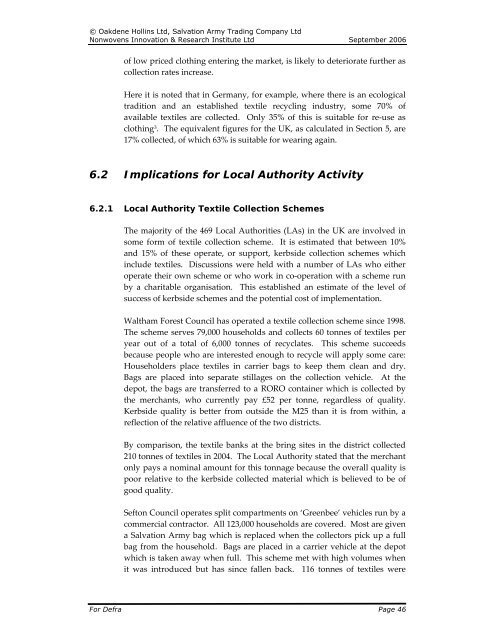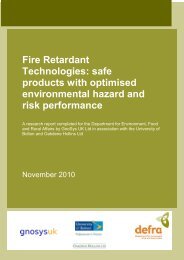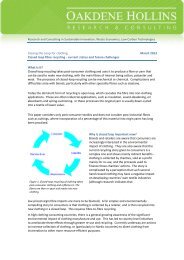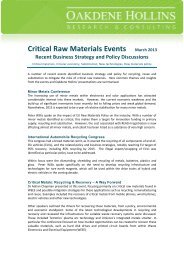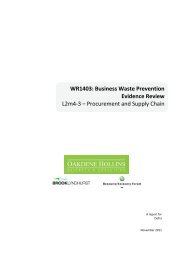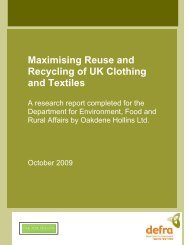Recycling of Low Grade Clothing Waste - Oakdene Hollins
Recycling of Low Grade Clothing Waste - Oakdene Hollins
Recycling of Low Grade Clothing Waste - Oakdene Hollins
You also want an ePaper? Increase the reach of your titles
YUMPU automatically turns print PDFs into web optimized ePapers that Google loves.
© <strong>Oakdene</strong> <strong>Hollins</strong> Ltd, Salvation Army Trading Company Ltd<br />
Nonwovens Innovation & Research Institute Ltd September 2006<br />
<strong>of</strong> low priced clothing entering the market, is likely to deteriorate further as<br />
collection rates increase.<br />
Here it is noted that in Germany, for example, where there is an ecological<br />
tradition and an established textile recycling industry, some 70% <strong>of</strong><br />
available textiles are collected. Only 35% <strong>of</strong> this is suitable for re‐use as<br />
clothing 3 . The equivalent figures for the UK, as calculated in Section 5, are<br />
17% collected, <strong>of</strong> which 63% is suitable for wearing again.<br />
6.2 Implications for Local Authority Activity<br />
6.2.1 Local Authority Textile Collection Schemes<br />
The majority <strong>of</strong> the 469 Local Authorities (LAs) in the UK are involved in<br />
some form <strong>of</strong> textile collection scheme. It is estimated that between 10%<br />
and 15% <strong>of</strong> these operate, or support, kerbside collection schemes which<br />
include textiles. Discussions were held with a number <strong>of</strong> LAs who either<br />
operate their own scheme or who work in co‐operation with a scheme run<br />
by a charitable organisation. This established an estimate <strong>of</strong> the level <strong>of</strong><br />
success <strong>of</strong> kerbside schemes and the potential cost <strong>of</strong> implementation.<br />
Waltham Forest Council has operated a textile collection scheme since 1998.<br />
The scheme serves 79,000 households and collects 60 tonnes <strong>of</strong> textiles per<br />
year out <strong>of</strong> a total <strong>of</strong> 6,000 tonnes <strong>of</strong> recyclates. This scheme succeeds<br />
because people who are interested enough to recycle will apply some care:<br />
Householders place textiles in carrier bags to keep them clean and dry.<br />
Bags are placed into separate stillages on the collection vehicle. At the<br />
depot, the bags are transferred to a RORO container which is collected by<br />
the merchants, who currently pay £52 per tonne, regardless <strong>of</strong> quality.<br />
Kerbside quality is better from outside the M25 than it is from within, a<br />
reflection <strong>of</strong> the relative affluence <strong>of</strong> the two districts.<br />
By comparison, the textile banks at the bring sites in the district collected<br />
210 tonnes <strong>of</strong> textiles in 2004. The Local Authority stated that the merchant<br />
only pays a nominal amount for this tonnage because the overall quality is<br />
poor relative to the kerbside collected material which is believed to be <strong>of</strong><br />
good quality.<br />
Sefton Council operates split compartments on ‘Greenbee’ vehicles run by a<br />
commercial contractor. All 123,000 households are covered. Most are given<br />
a Salvation Army bag which is replaced when the collectors pick up a full<br />
bag from the household. Bags are placed in a carrier vehicle at the depot<br />
which is taken away when full. This scheme met with high volumes when<br />
it was introduced but has since fallen back. 116 tonnes <strong>of</strong> textiles were<br />
For Defra Page 46


